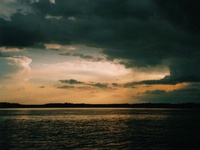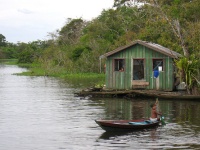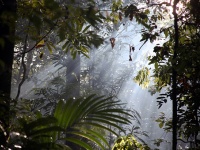Things to do in The Amazon
Those looking for bustling nightlife, luxury shopping trips and fancy restaurants in the Amazon will be disappointed.. For those who are keen to marvel at unrivalled natural wonders and have authentic experiences in one of the world's last mostly unspoilt locations however, the Amazon is just the ticket.The Amazon is one of the world's greatest natural wonders, home to 2.5 million insect species, tens of thousands of plants, and some 2,000 different kinds of birds and mammals. It teems with unique wildlife, from scarlet macaws, jaguars and giant anacondas, to poison dart frogs, piranhas and electric eels. The list of weird and wonderful creatures to tick off the list is endless.
In response to deforestation and climate change, the Amazon's tourism industry has started moving toward ecotourism; benefiting the local people, while also providing an unforgettable experience for visitors. The impact on the environment is always important to consider when travelling to undeveloped areas, and requesting things such as non-motorised boats and only qualified, locally-trained nature guides can make a big difference.
Because the Amazon is so large, there are a multitude of regions, each as uniquely fascinating and worthwhile as the next. Manaus is the largest city in the Amazon, with around two million inhabitants. It's a great base from which to travel, as one can find plenty of boat- and land trips into the jungle. Manaus has a variety of parks, beaches, a zoo and the wonderful Amazon Theatre for sightseers, and there are a number of lodges within range of Manaus that cater for tourists.
Belem is much smaller, with beautiful colonial architecture lining its streets, a number of interesting natural indentations and islands on its coast, and several bustling markets, including the Iron Market and the Ver-o-Peso, both near the waterfront.
There are many protected areas and national parks within the Amazon that provide great opportunities to interact with nature. Mamirauá Sustainable Development Reserve near Tefe is a protected area covered in swamp and flooded forest accessible by canoe. Its infrastructure is set up for ecotourism, including a unique floating lodge.
Cabo Orange National Park is the only protected area of the Amazon on the coastline, so the flora and fauna are unique to the rest of the rainforest. Infrastructure is lacking, but you can visit it from the nearby Oiapoque City. Cantão State Park has better facilities for tourists and an interesting topography that transitions from flat plains to rainforest.
The sun beats down mercilessly this close to the equator, especially during summer, so make sure to bring plenty of sunscreen, hats and other protective gear. Be careful not to remove any plants, animals or seeds from the rainforest, as poaching and smuggling are a big problem in the region and the authorities won't hesitate to prosecute.
The Amazon is rural and generally poverty-stricken, so tourists shouldn't expect to use credit cards outside of the cities. Tourists are overcharged as a rule, so it is always a good idea to haggle.

The Meeting of the Waters
The Meeting of Waters is an incredible natural phenomenon occurring when the dark waters of the Rio Negro join the lighter-coloured stream of the Rio Solimoes. The difference betwe…
The Meeting of the Waters
The Meeting of Waters is an incredible natural phenomenon occurring when the dark waters of the Rio Negro join the lighter-coloured stream of the Rio Solimoes. The difference between the blackwater and whitewater rivers is stark, running side by side for a length of more than four miles (6km) without mixing. The separation is caused by differences in temperature, density and flow, with the resultant display a true wonder of nature. Becoming a major tourist attraction in Brazil, the Meeting of Waters is accessed via an hour's boat journey from the floating docks in Manaus.

Lake Janauari Ecological Park
An hour by boat from Manaus on the Rio Negro, this breathtaking park provides visitors with a taste of the Amazon experience, encompassing 22,240 acres (9,000 hectares) of forest, …
Lake Janauari Ecological Park
An hour by boat from Manaus on the Rio Negro, this breathtaking park provides visitors with a taste of the Amazon experience, encompassing 22,240 acres (9,000 hectares) of forest, lowlands and flooded forest (igapos). Day package trips are available from Manaus, including lunch in a typical regional restaurant and a visit to the area's other main attraction, The Meeting of the Waters, as well as a canoe trip exploring the park's lakes and streams. Visitors can also spot the symbol of the Amazon at Lake Janauari Park: the famous Victoria amazonica, a water lily measuring up to seven feet (2m) in diameter, and ubiquitous atop the still shallow waters. The beautiful flowers only bloom for three days, changing colour from white to dark red before dying.

Adolpho Ducke Botanical Garden
This vast forest reserve, covering more than 39 square miles (100 sq km) to the east of Manaus, provides tourists with the opportunity to discover what lies beneath the dense Amazo…
Adolpho Ducke Botanical Garden
This vast forest reserve, covering more than 39 square miles (100 sq km) to the east of Manaus, provides tourists with the opportunity to discover what lies beneath the dense Amazon canopy. The park building complex contains plant nurseries and an exhibition of the woods of Amazonas, as well as a library and an eatery. A network of trails has been created in the forest, and local youths are trained and employed as guides to direct visitors along the paths (although not all of them speak English). It can be difficult to get into the Amazon for a genuine experience of the rainforest and this vast botanical garden offers a convenient opportunity for a close look at a microcosm of this unspoilt forest world.
Website www.museudaamazonia.org.br/en/



